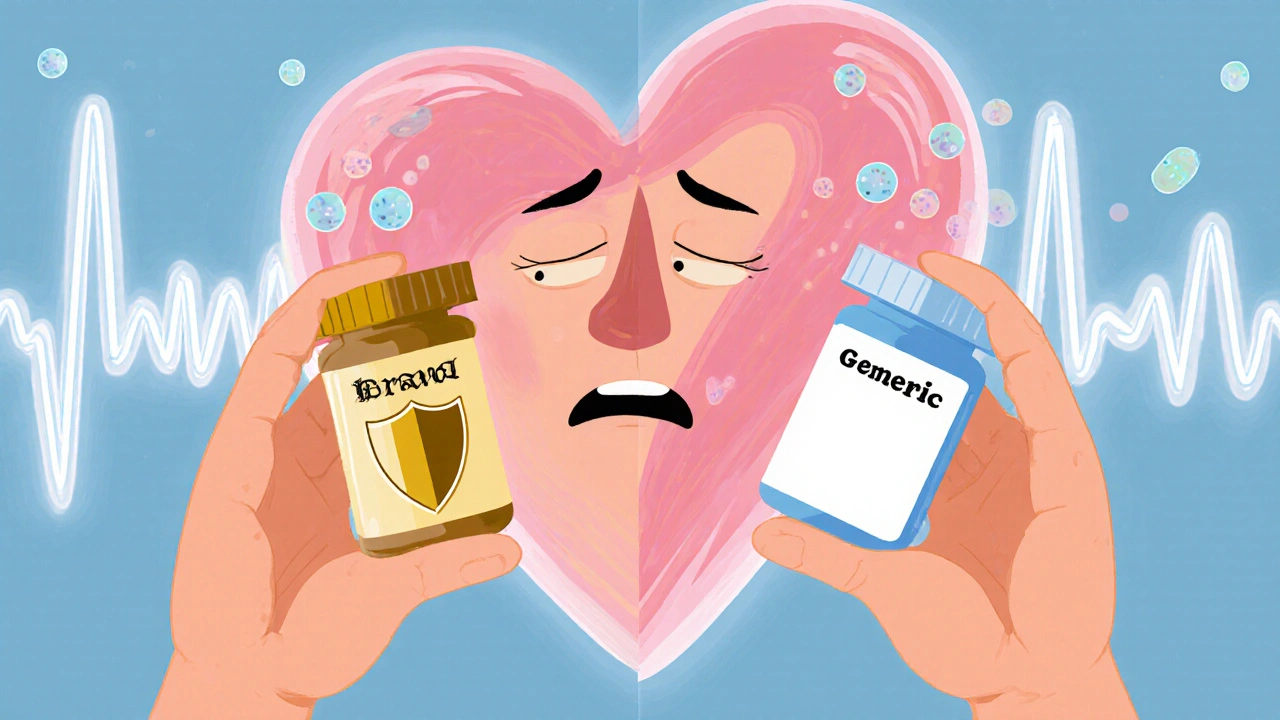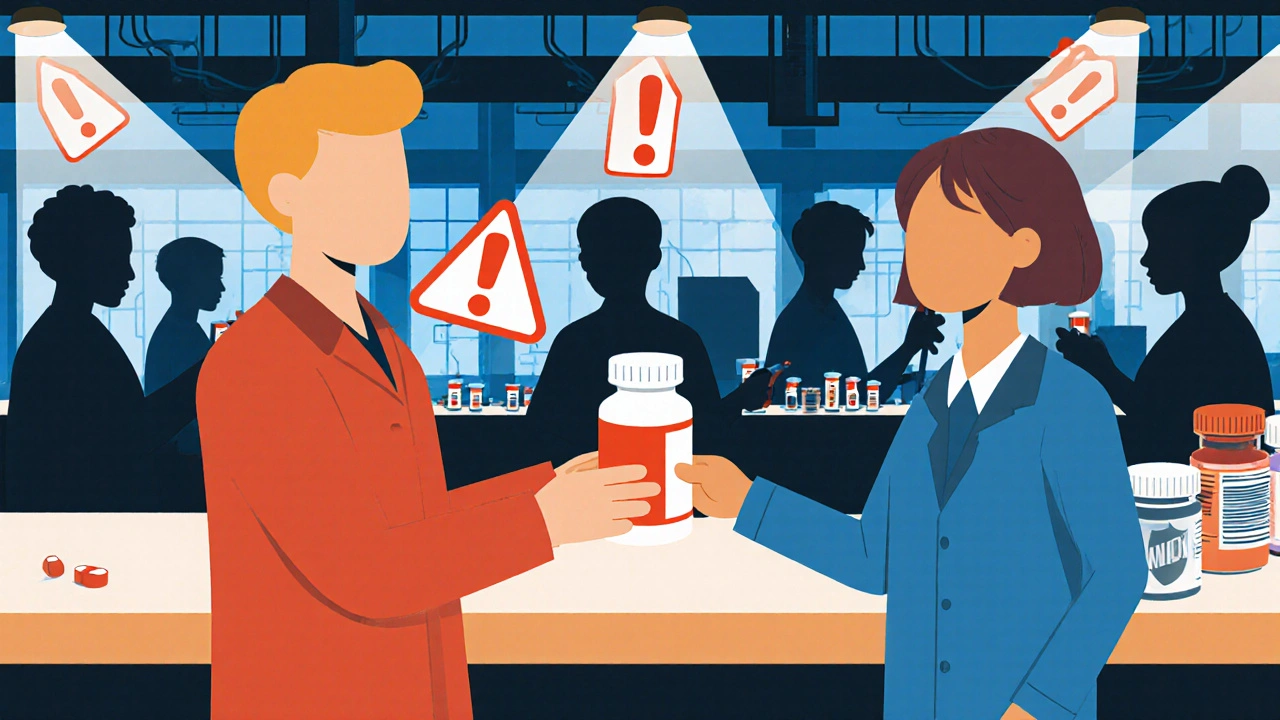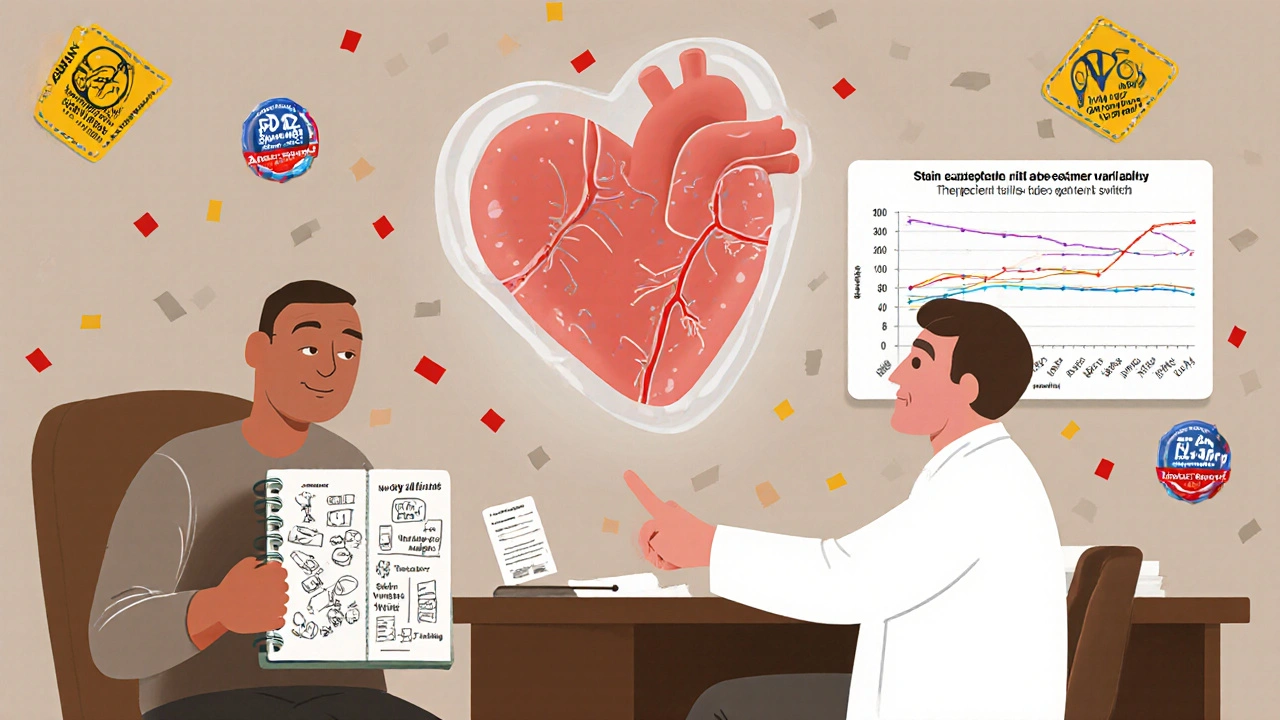
When you fill a prescription for a blood pressure pill or a statin, there’s a good chance it’s not the brand name you see on the box. In fact, cardiovascular generics make up more than 90% of all heart medication prescriptions in the U.S. They’re cheaper, widely available, and approved by the FDA. But do they work just as well? Are they safe? And why do some patients and even doctors still hesitate to use them?
What Exactly Are Cardiovascular Generics?
Cardiovascular generics are exact chemical copies of brand-name heart drugs-like losartan, atorvastatin, or metoprolol-after the original patent expires. The FDA requires them to have the same active ingredient, dose, strength, and route of delivery. That means a generic lisinopril tablet must contain the same molecule as the brand-name Zestril. But here’s where it gets tricky: the inactive ingredients-fillers, dyes, coatings-can be different. And that small difference sometimes matters.
Manufacturers must prove bioequivalence: the generic must absorb into the bloodstream at a rate and level within 80-125% of the brand-name drug. That’s not perfect match-it’s an acceptable range. For most people, this works fine. But for drugs with a narrow therapeutic index-like warfarin or some antiarrhythmics-even tiny changes in absorption can lead to problems.
What Do the Studies Say About Safety?
Large studies paint a mixed picture. A 2020 Harvard Health meta-analysis of 38 randomized trials found that 35 of them (92.1%) showed no difference in outcomes between generic and brand-name cardiovascular drugs. That sounds reassuring. But two other major studies tell a different story.
A 2019 Canadian study tracked over 136,000 seniors after generic versions of ARBs (losartan, valsartan, candesartan) hit the market. In the first month after switching, adverse events rose-from 10% to 14% in some cases. The same pattern showed up in Quebec: 8-14% more hospital visits for heart failure or high blood pressure spikes after patients were switched to generics.
Then there’s the 2023 meta-analysis in PMC11951291. It found no overall difference in major heart events like heart attacks or strokes. But when broken down by drug class, the numbers got interesting: generic statins had a 13% higher risk of major adverse events, while generic calcium channel blockers actually had fewer side effects than the brand names.
Why the inconsistency? It’s not about the active ingredient. It’s about how the body handles the pill. Different fillers can change how quickly the drug dissolves. For someone on a tight dose of a statin, even a 5% difference in absorption could mean higher LDL cholesterol. For someone with kidney disease on an ARB, a slower release could mean less protection.
Why Do Patients Worry-And Should They?
Consumer Reports found that 61% of Americans believe brand-name drugs are more effective. That’s not just misinformation-it’s rooted in real experiences.
One patient in Bristol told me she switched from brand-name metoprolol to a generic and started feeling dizzy and fatigued. Her doctor said it was "just psychological." But when she switched back, her symptoms disappeared. This isn’t rare. A JAMA Internal Medicine study showed a 14.2% increase in patients stopping their meds after a pill color or shape changed during generic substitution. That’s not a placebo effect-it’s a psychological trigger tied to physical changes.
And then there’s the 2018 nitrosamine scandal. The FDA recalled over 1,200 lots of generic valsartan, losartan, and irbesartan because they contained cancer-causing impurities. Those weren’t manufacturing mistakes-they were systemic failures in quality control. Even though the FDA now requires stricter testing for these impurities, the damage to trust remains.

Who’s Really in Charge of Quality?
Most generic drugs sold in the U.S. are made overseas. In 2022, the FDA found critical deficiencies in 12.7% of generic manufacturing facilities. That’s not a small number. And inspections are often scheduled in advance. The 2023 Unannounced Inspection Pilot Program showed that when inspectors showed up without warning, nearly half of cardiovascular generic plants had violations.
Teva, Mylan, and Sandoz control nearly half the market. But quality isn’t consistent across all their factories. One batch might pass, another might contain impurities. That’s why the FDA’s Adverse Event Reporting System got 2,147 reports on generic cardiovascular drugs in 2022. Underreporting is a huge issue-most patients never connect their symptoms to the pill they took.
What Do Doctors Really Think?
Surveys show a disconnect between evidence and practice. The American College of Physicians found that 25% of physicians wouldn’t use generics for their own families. That’s not because they’re misinformed-it’s because they’ve seen the consequences.
Cardiologists report that 34.7% of their patients ask about safety after hearing about recalls or online rumors. Nearly 1 in 5 patients refuse generic substitution outright. Pharmacists, who see the most of this, say 67% of them spend extra time counseling patients-not because generics are unsafe, but because patients are scared.
Yet, the same doctors who hesitate to prescribe generics for their own relatives often prescribe them for everyone else. Why? Because insurance won’t cover the brand name. Or because the hospital’s formulary mandates generics. It’s a system built on cost, not trust.

When Should You Stick With Brand Name?
There are clear cases where sticking with brand name makes sense:
- Warfarin and other anticoagulants with narrow therapeutic windows
- Patients who’ve had adverse reactions to a specific generic version
- Those with known allergies to inactive ingredients (like dyes or lactose)
- People who’ve stabilized on a brand-name drug and show no benefit from switching
The American Heart Association recommends against automatic substitution for these drugs without close monitoring. If your doctor switches you to a generic, ask for a follow-up blood test-especially if you’re on a statin, ARB, or beta-blocker. Your cholesterol, blood pressure, or kidney function might tell you more than your gut feeling.
What Can You Do?
You don’t have to accept whatever your pharmacy gives you. Here’s how to take control:
- Ask your pharmacist: "Is this generic made by the same company as the last one?" If the pill looks different, ask why.
- Keep a symptom journal. Note fatigue, dizziness, swelling, or chest discomfort after a switch.
- Request a brand-name drug if you’ve had issues before. Insurers must approve it if you document medical necessity.
- Ask for a medication therapy management session. A 2020 UPMC study showed pharmacist-led counseling cut discontinuation rates by 22.7%.
- Check the FDA’s drug shortage and recall list regularly. You can sign up for alerts.
Generics saved the U.S. healthcare system over $1.6 trillion between 2010 and 2019. That’s huge. But money shouldn’t be the only factor when your heart is involved.
What’s Next for Cardiovascular Generics?
More generics are coming. Sacubitril/valsartan (Entresto) is set to go generic in 2026. But these are complex drugs-not simple pills. The FDA is now requiring advanced testing for them, including food-effect studies, because absorption changes with meals. The European Medicines Agency already did this for rivaroxaban in early 2024.
Manufacturers are under more pressure than ever. With 14.9% of tested generic lots in Q1 2024 exceeding nitrosamine limits, the race to cut costs is still on. But the stakes are higher now. One bad batch can lead to a nationwide recall. And trust, once broken, takes years to rebuild.
For now, the evidence says this: for most people, most of the time, cardiovascular generics are safe and effective. But not always. And when they’re not, the consequences can be serious. Don’t assume. Don’t guess. Ask questions. Track your symptoms. Your heart deserves nothing less.
Are generic cardiovascular drugs as safe as brand-name ones?
For most people, yes. Large studies show that 90%+ of the time, generics perform the same as brand-name drugs. But exceptions exist. Some patients experience more side effects after switching, especially with ARBs and statins. Differences in inactive ingredients, manufacturing quality, and individual sensitivity can affect outcomes. If you feel worse after switching, talk to your doctor-don’t assume it’s all in your head.
Why do some studies show higher hospital visits with generics?
The increase isn’t because generics are inherently dangerous. It’s often tied to abrupt switches without monitoring. Patients may react to changes in pill appearance, or a slight difference in absorption rate can throw off a delicate balance-especially with drugs like ARBs or statins. A 2019 Canadian study found adverse events spiked in the first month after switching, then dropped back to normal. This suggests the issue is transition-related, not drug-related.
Can I ask my doctor to keep me on the brand-name drug?
Yes. If you’ve had a bad reaction to a generic, or if your condition is unstable, your doctor can write "Dispense as Written" or "Do Not Substitute" on your prescription. Insurance may require prior authorization, but if you document symptoms or lab changes after switching, they usually approve it. Your health comes before cost savings.
Are there specific cardiovascular generics I should avoid?
There’s no official blacklist, but generics for drugs with narrow therapeutic windows-like warfarin, digoxin, or certain antiarrhythmics-carry higher risk. Statins and ARBs also show more variability in outcomes. If you’re on one of these, stick with the same manufacturer if possible. Don’t switch generics unless you have to. And always monitor your labs after a switch.
How do I know if my generic drug is safe?
Check the FDA’s Drug Shortages and Recalls page regularly. If your pill looks different, ask your pharmacist who made it. Keep a record of your symptoms before and after switching. If you notice new fatigue, dizziness, swelling, or chest discomfort, contact your doctor. Don’t wait. Your body is telling you something.





